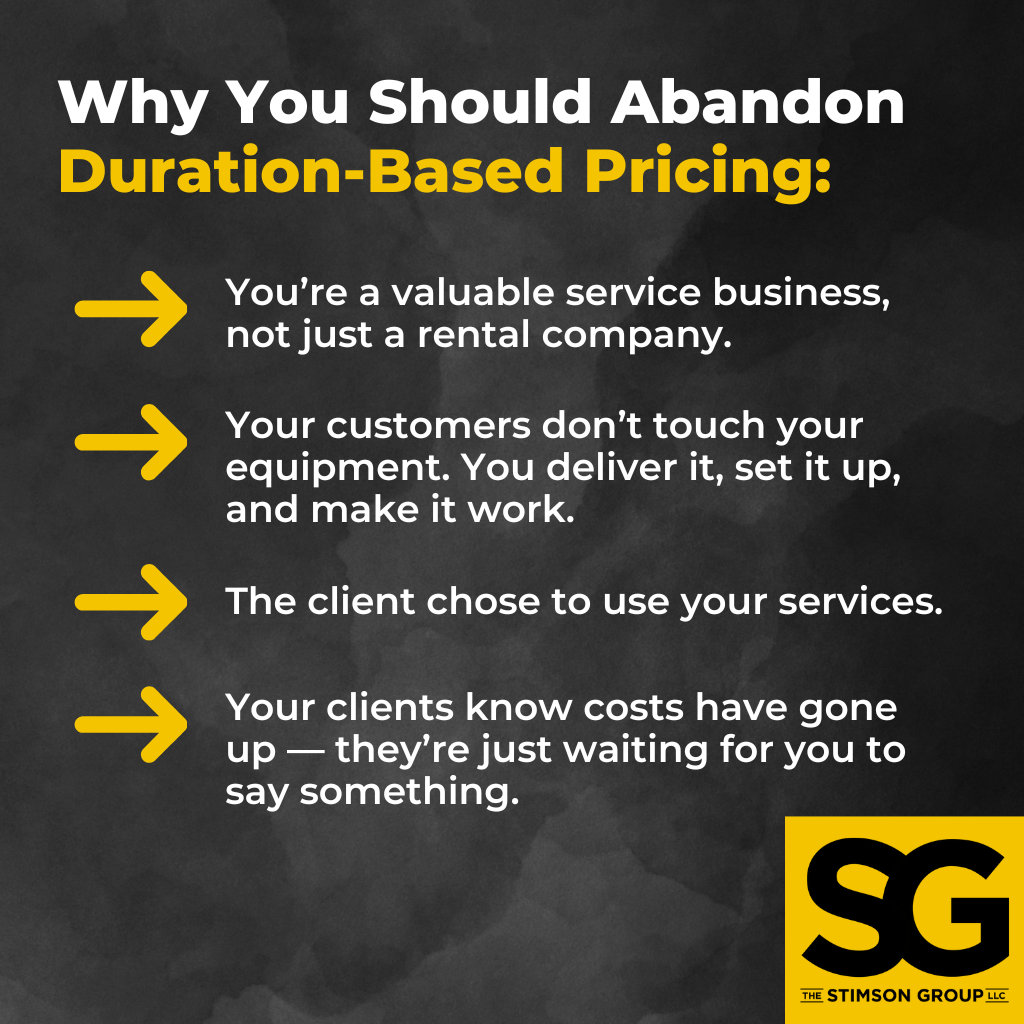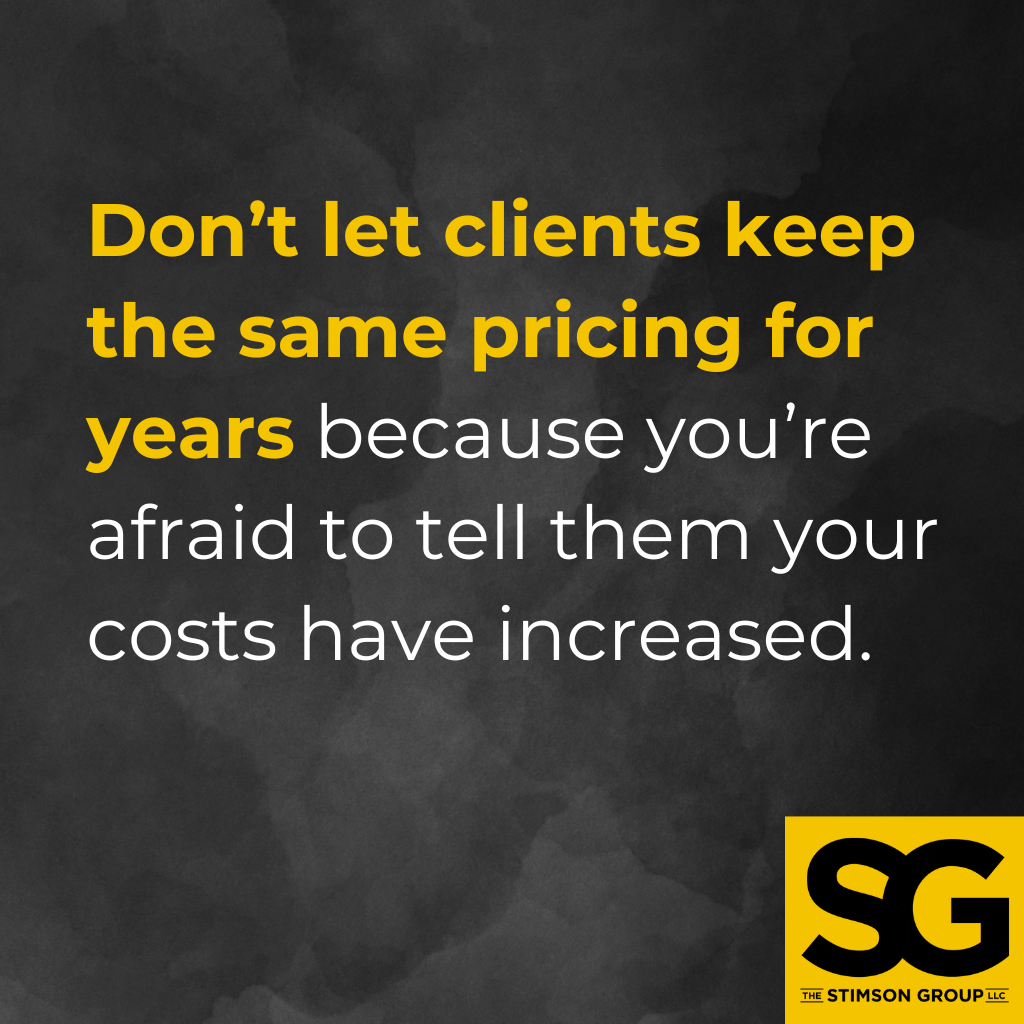
Listen instead on your Monday Morning Drive:
We all know managing pricing variables is a nightmare.
When putting together a quote, you’re thinking about a ridiculous number of variables: rental day rates, multipliers, discounts, different types of labor, up-charges, markup percentages, special rules for sub-rentals, etc.
If you can’t raise your rental or labor prices without creating a firestorm of resistance from key customers and a reluctant sales team, you have a transactional problem. You’re a valuable service business, not just a rental company.
It’s time to fix this.

Stop Pricing Based on Duration
Duration is a rental concept. In rental thinking, duration is the period of time the customer keeps the rented car, house, or microphone.
You can rent lawn equipment from Home Depot for as little as four hours. The rate for 24 hours, a week, or a month is clearly written on the contract. The discount is in the duration; a 24-hour rental isn’t six times the four-hour rate — it’s barely 25% more.
But you’re not in the tool rental business, are you?
Your customers don’t touch your equipment. You deliver it, set it up, and make it work. These are your tools. When a plumber comes to your house with a truckload of equipment, you don’t take possession of that truck while they’re working for you.
So, the idea that we’re renting our tools to customers for their use is already mislabeled.
Let me put it a different way: If you arrive at a job site, set up, and get everything show-ready in 30 minutes for a five-minute announcement, then pack up and leave, is that job worth any less than if it were a seven-hour business meeting that required you to stay all day? No.
The client chose to use your services for five minutes. Their five-minute presentation took the same amount of time, energy, and resources that an all-day presentation would have.
That’s not your problem — it’s just how they chose to spend their money.
When a Client Hasn’t Paid More in a Decade
Recently, one of my clients tried to raise his outdated pricing for a long-standing client who was still paying pre-pandemic rates (seriously!) on a fairly complex two-and-a-half-day job with audio, video, lighting, and support.
This was a standard two-and-a-half-day training event: set up the night before, two and a half days of meetings, then pack up and leave by the third afternoon. My client wanted to raise his price halfway to his current standard — from X to 2.5X, instead of the full 5X he should have been charging.
The event producer, who my client was afraid of losing, knew what was happening. He knew hotel rates, food costs, air travel, and every other fee he paid had increased while his AV supplier had a flat budget. He felt like he’d gotten away with murder.
Even the worst AV supplier this client could have hired would’ve charged more than my client’s proposed new rate. The buyer was going to act like it was a big deal, but there was no way he would get a better price elsewhere.
The end client came back and asked how much less it would be if they cut the last half-day from the schedule and made it a two-day meeting instead.
My client called me to ask how much less to charge. I asked him, “How much will your costs be reduced if they cut that last bit of the meeting?”
He wouldn’t save a penny. He might get lucky if he had a local tech who didn’t need to be hired for a third day, but all the shows were traveling jobs with traveling techs. There wasn’t a single cost he wouldn’t incur if the event was shorter by half a day.
It took some coaching, but I convinced him to tell the client, “It doesn’t reduce my costs — this is still the fee.”
The good news? The client agreed to the new rate and signed up for the following year’s events.
Your New Pricing Rule: The “One-Day Week”
This leads to today’s lesson.
I want you to adopt the “one-day week.” When it comes to rental equipment and using your assets, a day is the same as a week.
You need to dramatically increase your price for a one-day show. The easiest way to do this in our pricing methodology is to completely eliminate one-day rentals. All rentals are a week long.
You know it takes the same amount of time to prep the gear, the same knowledge to spec the gear, and the same talent to set it up correctly. The cost of your labor is higher on a one-day job because finding quality people for short gigs is harder. One-day jobs should probably cost customers twice what they’re paying now.
Pay More to Get Better Talent
If talent is so important and difficult to procure, maybe you should charge for two days of labor instead of one on a one-day show. Would paying somebody for two days to do a one-day show increase the quality of people available to you? Absolutely.
As a freelancer, I’d take those gigs all day long. I’d work five one-day gigs every week so I could earn 10 times my show rate. But you need to charge for that — and why wouldn’t you? It’s worth it.
The worst that could happen is you lose low-margin one-day gigs to someone else.
Put This Into Action Now
In practical terms, a day is the same as a week in rental when applied to a one-day job. This gives you more negotiating room because you know that sometimes on a one-day job, you’ll have sub-rentals you can still negotiate a one-day rate on.
Your customer might say, “I can rent that for one day elsewhere!”
You can respond, “Yes, you probably should — while they’re still doing that. But here’s what it’ll cost for me and my talented crew to do your project based on my costs.”
Everyone makes money off their supply chain. You don’t want to be the link in the supply chain that realized too late that everyone else is making more money than you. If your costs are higher than they were a year ago, you’re already bleeding profit, and it’ll only get worse.
Don’t let clients keep the same pricing for years because you’re afraid to tell them your costs have increased. Your clients know costs have gone up — they’re just waiting for you to say something.
Switching to a week rate for your hardware makes sense. You can still negotiate a lower price and provide discounts, but your starting point will make much more sense. You’ll have a much better understanding of where you’re creating value and where you deserve to make gross profit.
That’s your money. You’ve earned it.






Leave a Reply